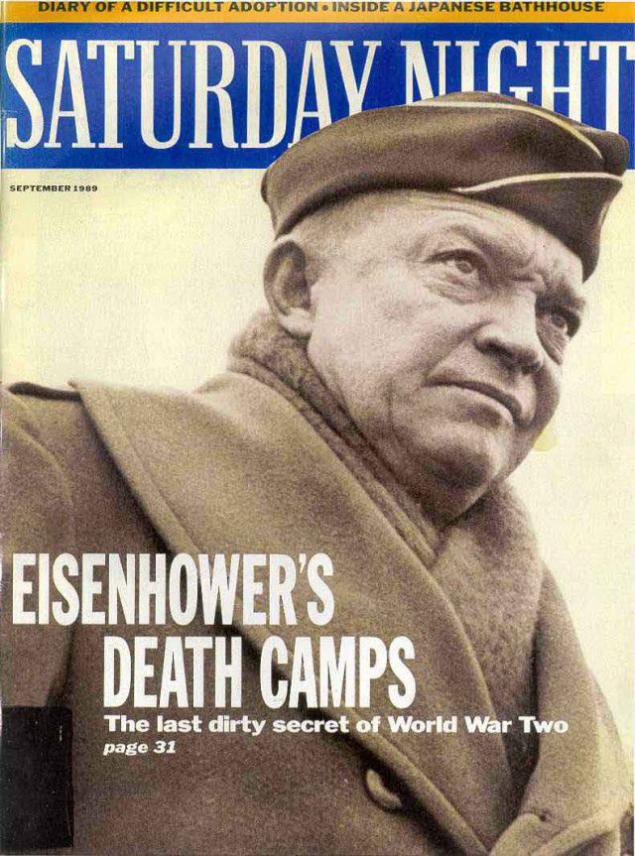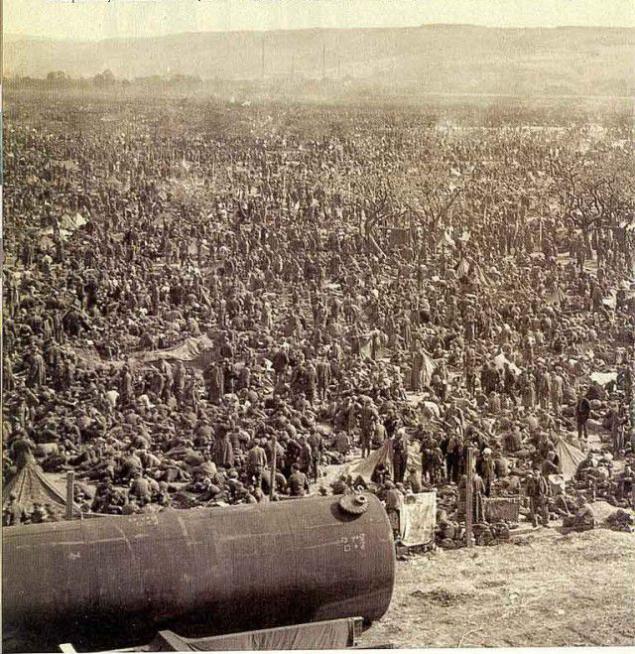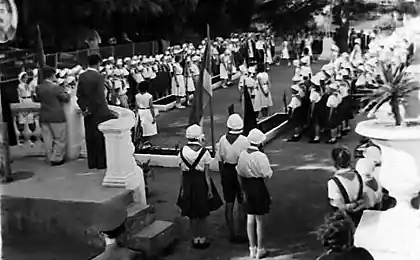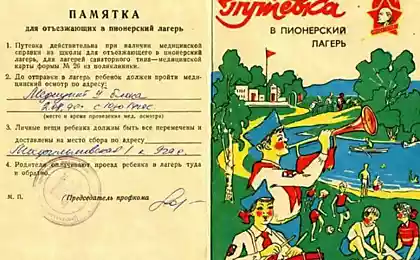1629
Death camp
Call it callousness, call it reprisal, call it politics hostile negation: a million Germans, captive armies Eisenhower, died in captivity after the surrender of the spring of 1945 the Third Reich of Adolf Hitler was on the verge of death being ground up by the Red Army, advancing to the west in the direction of Berlin and the American, British and Canadian armies under the command of General Dwight D. Eisenhower, advancing to the east of the Rhine. From the day of the Normandy landings in June last year, the Western Allies retook France and smaller European countries, and some Wehrmacht commanders were ready to surrender local. Other units, however, continued to obey Hitler's orders to fight to the last. Most of the infrastructure, including transport, was destroyed, and the people wandered in fear of the approaching Russian.
"Hungry and frightened, lying in the fields within fifty feet away, waved his arms ready to fly" - So the captain of the Second Regiment anti-Second Canadian Division HF McCullough describes the chaos of Germany's surrender at the end of the Second World War. For half a day, according to the assertions of Field Marshal Montgomery, 500,000 Germans surrendered to his 21st Army Group in northern Germany.
Shortly after the Victory Day - May 8, British and Canadian troops captured more than 2 million. Almost nothing about their treatment has not been preserved in the archives of London and Ottawa, but some scant evidence of the International Committee of the Red Cross, the respective military and prisoners themselves indicate that the state of health of prisoners was excellent. In any case, many were quickly released and sent home or transferred to France for post-war reconstruction. The French army itself is captured about 300,000 Germans.)

Like the British and the Canadians, the Americans suddenly met with a large number of German troops surrounded: the total number of prisoners of war only from the Americans reached without Italy and North Africa 2, 5 million. But the attitude of the Americans was very different.
Among the first US prisoners of war was Corporal Helmut Liebich, who served in the anti-intervention group in Peenemunde on the Baltic Sea. Liebig was captured by the Americans on April 17 near Gotha in central Germany. Forty-two years later, he clearly recalled that in the camp Gotha was not even tents, a barbed-wire fence around the field, soon turned into a swamp.
The prisoners received the first day of a small portion of food, but on the second and subsequent days it was reduced by half. To get it, they were forced to run through the system. Hunched over, they ran between the rows of American guards who beat them with sticks as they approach to food. April 27, they were transferred to the US camp Heidesheim, where for a few days there was no food at all, and then only slightly.
Under the open sky, starved, tormented by thirst, the people began to die. Liebig counted daily from 10 to 30 bodies, which pulled out of its section B, which contained about 5 200 people. He saw one prisoner scored another to death because of a small piece of bread.
One night, when the rain fell, Liebig said that the wall of the hole dug in the sandy soil to shelter, collapsed on people who were too weak to get out from under them. They suffocated before it could come to the aid of their comrades ...

A German newspaper, Rhein-Zeitung, the so-called the Americans who survived the photo posted on his band: Camp in Sinzig-Remagen, spring 1945.
Liebich sat down and wept. "I could not believe that people were so cruel to each other».
Typhus broke in Heidesheim in early May. Five days after the surrender of Germany on May 13, Liebig was transferred to another American POW camp, Bingem-Rudesheim in the Rhineland near Bad Kreusnach. The prisoners there contain 200 - 400 thousand, homeless, with little or no food, water, medicines, in terrible distress.
Soon he fell ill with typhus and dysentery at the same time. His half-conscious and delirium, with sixty prisoners were taken in an open car in the north-west down the Rhine on a tour of Holland, where the Dutch stood on bridges and spat on their heads. Sometimes the American guards opened warning fire to ward off the Dutch. Sometimes - no.
Three days later comrades helped him hobble to the big camp in Rheinberg, near the border with Holland, again without shelter and almost without food. When a bit of food was delivered, it was rotten. None of the four camps Liebig did not see any shelter for the prisoners - all of them were located in the open air.
Mortality in the American camps for German prisoners of war in the Rhineland, according to the testimony of the surviving medical service, was about 30% in 1945. The average mortality rate among the civilian population of Germany at the time was 1-2%.
One day in June, through the hallucinations, Liebich saw "Tommy", included in the camp. The British took the camp under its protection, and it saved the life of Liebig. Then he with growth 5 feet 10 inches weighed 96 pounds 8.
CAM Eisenhower signed an order creating categories of prisoners are not subject to the Geneva Convention.
According to the stories of former prisoners Reinberg, the last action of the Americans before the arrival of the British was zaravnivanie one section of the camp with a bulldozer, with many weakened prisoners were unable to leave their burrows ...
According to the Geneva Convention, prisoners of war were guaranteed three important rights: they need to be fed and housed by the same standards. as the winners, they should be able to send and receive mail, and that they are required to attend the delegation of the International Committee of the Red Cross, who should be secret reports on the conditions of the defending party.
(In the case of Germany, since her government was dissolved in the final stages of the war, the defending party has been appointed Switzerland). In fact, the German prisoners had been denied by the US military in these and most other series of special rights decisions and directives adopted at its command of SHAEF - Supreme Headquarters, Allied Expeditionary Force - the Supreme Headquarters of the Allied Expeditionary Force.
General Dwight Eisenhower was as the Supreme Commander of SHAEF - all the Allied armies in Northwest Europe and commander of US forces in the European theater of operations.
He submitted to the Joint Command of the US and Britain (CCS), the US Joint Chiefs (JCS), as well as the policy of the US government, but due to lack of relevant directives entire responsibility for the treatment of German prisoners of war is fully on it.
"God, I hate the Germans" - he wrote to his wife Mamie in September 1944. Previously, he told the British ambassador in Washington that all 3500 officers of the German General Staff should be "destroyed." In March 1945, in a letter to CCS, signed by Eisenhower recommended the creation of a new class of prisoners - Disarmed Enemy Forces - DEF - disarmed enemy forces, which, unlike the prisoners did not fall under the Geneva Convention. Therefore, they should not have been supplied with the winning army after Germany's surrender.
This was a direct violation of the Geneva Convention. In a letter dated March 10, in particular. It was argued: "The additional load on the supply of troops due to recognition of the German Armed Forces of Prisoners of War, requiring them to provide a basic level of army rations, is far beyond the capabilities of the Allies, even if you use all the resources of Germany." The letter concluded: "Your approval is required. Plans will be drawn up on this basis ».
April 26, 1945 Joint Command approved the DEF status only for prisoners of war in the hands of the US Army: British command refused to accept the American plan for their prisoners. CCS has decided to keep the status of German troops disarmed in secret.
At the same time the chief quartermaster Eisenhower at SAEF, General Robert Littlejohn, had already twice reduced rations for prisoners and an SAEF, converted to General George Marshall, Chief of the US Army, signed by Eisenhower, was that in the camps for prisoners of war would not be "neither a roof nor Other facilities ... ».
However, the reason was not the supply. In Europe, the warehouses were plenty of suitable materials for the construction of camps for prisoners of war. Adjutant General Eisenhower on specific issues General Everett Hughes visited the huge influx of warehouses and Marseilles and reported: "supplies more than we could ever use. Extend within sight. "That is, purveyance, too, was not the cause. Stocks of wheat and maize in the US has been greater than ever before, the potato crop was also a record.
The Army Reserve was a supply of food, when a warehouse center in England stopped the supply after the accident, it was not seen in three months. In addition, from the International Committee of the Red Cross warehouses in Switzerland, there were more than 100 000 tons of food. When he tried to send a two-tier food in the American sector of Germany, the American command launched them back stating that the warehouses are full so that they will never be devastated. Thus, the reason for the policy of deprivation German prisoners of war in any case could not be a lack of supply. Water, food, tents, space, medical care - all necessary for prisoners is provided in fatal scarcity.
The camp Rheinberg, where Corporal Liebich broke in mid-May, die from dysentery and fever, it was not at the opening April 17 at all no food for the prisoners. As in other camps, "Rhine Floodplains", the Americans opened in mid-April, there were no guard towers, no tents, no barracks, no kitchen, no water, no toilets, no food ...
Georg Weiss, tank repairman, who now lives in Toronto, says about his camp on the Rhine: "All night we had to sit close to each other. But lack of water was the worst. In three and a half days we had no water at all had happened. We drank their urine ... »
Private Hans T. (his name is hidden at his request), who just turned eighteen, was in the hospital when the Americans came on April 18. He, along with other patients were taken to the camp in Bad Kreuznach Rhineland, which already at that time there were several hundred prisoners. Hans had a pair of shorts, shirts and shoes.
Hans was not the youngest in the camp - there were thousands of civilians displaced Germans. There were six children, pregnant women, and old men after 60. In the beginning, when the camp were more trees, some began to tear off limbs and a fire. Security ordered the fire put out. In many areas it was forbidden to dig holes in the ground for shelter. "We were forced to eat grass" - says Hans.
Charles von Luttichau was recovering at home, he decided to resist the tyranny of American troops. He was sent to a camp Kripp, on the Rhine near Remagen.
"We were kept in extremely crowded enclosed wire cages in the open with little or no food," - he recalls today.

Camp POW - Prisoners Of War - War, along the Rhine - the consequences of the victorious Allied invasion of Germany. The US Army officially captured about 5, 25 million German soldiers
More than half the days we did not get any food at all. And on other days - a meager diet of "K". I peeped that the Americans gave us one-tenth of the diet, which was prepared for yourself ... I complained to the head of the American camp that they violate the Geneva Convention, to which he replied: "Forget about the Convention. Here you have no rights. »
"The toilets were just logs thrown over a ditch dug at the fence of barbed wire. But because of the weakness of the people we could not reach them and went to the ground. Soon many of us are so weak that they could not even take off his pants.
WORKING team stripped from the corpses identification tags, stripped them and stacked layers, sprinkling calcium oxide.
So all of our clothes became filthy, also the space in which we went, sitting or lying. In such circumstances, people soon began to die. After a few days, many people trapped in the camp healthy, were dead. I've seen a lot of people pulling corpses to the gates of the camp, where they put them on each other in a truck that took them away from the camp. »
Von Luttichau Kripp was in the camp for about three months. His mother was German, and he later emigrated to Washington, where he became a military historian, describes the history of the US Army.
Wolfgang Iff, former prisoners Reinberg and now living in Germany, describes how some of the 10,000 prisoners pulled daily from 30 to 50 corpses. Iff said that he worked in the funeral and the team pulled out the bodies of their sector to the gate of the camp, where they were brought on wheelbarrows several large steel garages.
There Iff and his companions stripped corpses, bit off half the aluminum identification tag, folding body layers 15-20 in one layer, each layer sprinkled with ten layers of calcium oxide, forming piles a meter high, and then piled the debris in the bag tags for the Americans, and so over and over again ...
Some of the dead had died of gangrene after frostbite (spring was unusually cold). Some were too weak to hold the logs thrown across the ditches that served as toilets, fell and drowned.
Terms in American camps along the Rhine in late April were tested by two colonels of the Medical Corps of the US Army by James Mason and Charles Beasley, who has described them in the newspaper, which was published in 1950: "huddling behind barbed prvolokoy in a pile for warmth, they are terrifying: about 100,000 sluggish, apathetic, dirty, emaciated men with blank stares, dressed in a gray dirt field uniform stood on the ankle in the mud ...
The commander of the German division has reported that people have not eaten for at least two days, and the supply of water was a major problem - at 200 yards flowed affluent Rhine. "May 4, 1945 the first German prisoners of war held by the Americans, were transferred to the status DEF - disarmed enemy forces . On the same day the US military Depertament banned prisoners send and receive letters. (When the International Committee of the Red Cross proposed a plan to restore the email in July, it was rejected).
May 8, Victory Day, the German government has been abolished, while the US Department dismissed Switzerland as a protecting side for German prisoners. (Canadian Prime Minister Mackenzie King protested in the Foreign Cabinet London simultaneous displacement of Switzerland as a protecting hand to the British-Canadian camps but received a scathing response for their compassion).
After that, the State Department informed the International Committee of the Red Cross. that as the defending side. which you can send the reports is missing, and there is no need to visit the camps.
Since then, the inmates of American camps officially lost the opportunity to visit by independent observers, as well as the possibility of obtaining food parcels, clothing or medication of any humanitarian organization, as well as a mail address.
General Patton's Third Army was the only army in the entire European theater of war, which liberated prisoners of war, and thus saved from imminent death in May number of German troops. Omar Bradley and General George. S. H. Lee, Commander of Communications Zone Europe, ordered the release of prisoners within a week after the war, but the order of the SHAEF - Supreme Headquarters, Allied Expeditionary Force - the Supreme Headquarters Allied Expeditionary Force he was canceled May 15 .
On the same day, at the meeting, Eisenhower and Churchill agreed to reduce the ration of prisoners. From Churchill demanded an agreement on the level of rations as prisoners he had to say to reduce the beef diet of the British and wanted to make sure that "the prisoners as possible ... should have been supplied by the supplies that we have saved." Eisenhower replied that he was "given to the issues needed attention," but going all double-check to make sure "Is it possible to further decrease.»
He told Churchill that the POW - prisoners of war receive at 2000 calories per day (2,150 calories were taken Army Medical Corps of the United States as the absolute support at least for adults living in warm and leading a sedentary lifestyle. US forces prepared for 4000 calories a day) .
home.arcor.de/kriegsgefangene/usa/europe.html
home.arcor.de/kriegsgefangene/usa/johann_baumberger2.html#We%20came
www.the7thfire.com/Politics%20and%20History/us_war_crimes/Eisenhowers_death_camps.htm
Source:
"Hungry and frightened, lying in the fields within fifty feet away, waved his arms ready to fly" - So the captain of the Second Regiment anti-Second Canadian Division HF McCullough describes the chaos of Germany's surrender at the end of the Second World War. For half a day, according to the assertions of Field Marshal Montgomery, 500,000 Germans surrendered to his 21st Army Group in northern Germany.
Shortly after the Victory Day - May 8, British and Canadian troops captured more than 2 million. Almost nothing about their treatment has not been preserved in the archives of London and Ottawa, but some scant evidence of the International Committee of the Red Cross, the respective military and prisoners themselves indicate that the state of health of prisoners was excellent. In any case, many were quickly released and sent home or transferred to France for post-war reconstruction. The French army itself is captured about 300,000 Germans.)

Like the British and the Canadians, the Americans suddenly met with a large number of German troops surrounded: the total number of prisoners of war only from the Americans reached without Italy and North Africa 2, 5 million. But the attitude of the Americans was very different.
Among the first US prisoners of war was Corporal Helmut Liebich, who served in the anti-intervention group in Peenemunde on the Baltic Sea. Liebig was captured by the Americans on April 17 near Gotha in central Germany. Forty-two years later, he clearly recalled that in the camp Gotha was not even tents, a barbed-wire fence around the field, soon turned into a swamp.
The prisoners received the first day of a small portion of food, but on the second and subsequent days it was reduced by half. To get it, they were forced to run through the system. Hunched over, they ran between the rows of American guards who beat them with sticks as they approach to food. April 27, they were transferred to the US camp Heidesheim, where for a few days there was no food at all, and then only slightly.
Under the open sky, starved, tormented by thirst, the people began to die. Liebig counted daily from 10 to 30 bodies, which pulled out of its section B, which contained about 5 200 people. He saw one prisoner scored another to death because of a small piece of bread.
One night, when the rain fell, Liebig said that the wall of the hole dug in the sandy soil to shelter, collapsed on people who were too weak to get out from under them. They suffocated before it could come to the aid of their comrades ...

A German newspaper, Rhein-Zeitung, the so-called the Americans who survived the photo posted on his band: Camp in Sinzig-Remagen, spring 1945.
Liebich sat down and wept. "I could not believe that people were so cruel to each other».
Typhus broke in Heidesheim in early May. Five days after the surrender of Germany on May 13, Liebig was transferred to another American POW camp, Bingem-Rudesheim in the Rhineland near Bad Kreusnach. The prisoners there contain 200 - 400 thousand, homeless, with little or no food, water, medicines, in terrible distress.
Soon he fell ill with typhus and dysentery at the same time. His half-conscious and delirium, with sixty prisoners were taken in an open car in the north-west down the Rhine on a tour of Holland, where the Dutch stood on bridges and spat on their heads. Sometimes the American guards opened warning fire to ward off the Dutch. Sometimes - no.
Three days later comrades helped him hobble to the big camp in Rheinberg, near the border with Holland, again without shelter and almost without food. When a bit of food was delivered, it was rotten. None of the four camps Liebig did not see any shelter for the prisoners - all of them were located in the open air.
Mortality in the American camps for German prisoners of war in the Rhineland, according to the testimony of the surviving medical service, was about 30% in 1945. The average mortality rate among the civilian population of Germany at the time was 1-2%.
One day in June, through the hallucinations, Liebich saw "Tommy", included in the camp. The British took the camp under its protection, and it saved the life of Liebig. Then he with growth 5 feet 10 inches weighed 96 pounds 8.
CAM Eisenhower signed an order creating categories of prisoners are not subject to the Geneva Convention.
According to the stories of former prisoners Reinberg, the last action of the Americans before the arrival of the British was zaravnivanie one section of the camp with a bulldozer, with many weakened prisoners were unable to leave their burrows ...
According to the Geneva Convention, prisoners of war were guaranteed three important rights: they need to be fed and housed by the same standards. as the winners, they should be able to send and receive mail, and that they are required to attend the delegation of the International Committee of the Red Cross, who should be secret reports on the conditions of the defending party.
(In the case of Germany, since her government was dissolved in the final stages of the war, the defending party has been appointed Switzerland). In fact, the German prisoners had been denied by the US military in these and most other series of special rights decisions and directives adopted at its command of SHAEF - Supreme Headquarters, Allied Expeditionary Force - the Supreme Headquarters of the Allied Expeditionary Force.
General Dwight Eisenhower was as the Supreme Commander of SHAEF - all the Allied armies in Northwest Europe and commander of US forces in the European theater of operations.
He submitted to the Joint Command of the US and Britain (CCS), the US Joint Chiefs (JCS), as well as the policy of the US government, but due to lack of relevant directives entire responsibility for the treatment of German prisoners of war is fully on it.
"God, I hate the Germans" - he wrote to his wife Mamie in September 1944. Previously, he told the British ambassador in Washington that all 3500 officers of the German General Staff should be "destroyed." In March 1945, in a letter to CCS, signed by Eisenhower recommended the creation of a new class of prisoners - Disarmed Enemy Forces - DEF - disarmed enemy forces, which, unlike the prisoners did not fall under the Geneva Convention. Therefore, they should not have been supplied with the winning army after Germany's surrender.
This was a direct violation of the Geneva Convention. In a letter dated March 10, in particular. It was argued: "The additional load on the supply of troops due to recognition of the German Armed Forces of Prisoners of War, requiring them to provide a basic level of army rations, is far beyond the capabilities of the Allies, even if you use all the resources of Germany." The letter concluded: "Your approval is required. Plans will be drawn up on this basis ».
April 26, 1945 Joint Command approved the DEF status only for prisoners of war in the hands of the US Army: British command refused to accept the American plan for their prisoners. CCS has decided to keep the status of German troops disarmed in secret.
At the same time the chief quartermaster Eisenhower at SAEF, General Robert Littlejohn, had already twice reduced rations for prisoners and an SAEF, converted to General George Marshall, Chief of the US Army, signed by Eisenhower, was that in the camps for prisoners of war would not be "neither a roof nor Other facilities ... ».
However, the reason was not the supply. In Europe, the warehouses were plenty of suitable materials for the construction of camps for prisoners of war. Adjutant General Eisenhower on specific issues General Everett Hughes visited the huge influx of warehouses and Marseilles and reported: "supplies more than we could ever use. Extend within sight. "That is, purveyance, too, was not the cause. Stocks of wheat and maize in the US has been greater than ever before, the potato crop was also a record.
The Army Reserve was a supply of food, when a warehouse center in England stopped the supply after the accident, it was not seen in three months. In addition, from the International Committee of the Red Cross warehouses in Switzerland, there were more than 100 000 tons of food. When he tried to send a two-tier food in the American sector of Germany, the American command launched them back stating that the warehouses are full so that they will never be devastated. Thus, the reason for the policy of deprivation German prisoners of war in any case could not be a lack of supply. Water, food, tents, space, medical care - all necessary for prisoners is provided in fatal scarcity.
The camp Rheinberg, where Corporal Liebich broke in mid-May, die from dysentery and fever, it was not at the opening April 17 at all no food for the prisoners. As in other camps, "Rhine Floodplains", the Americans opened in mid-April, there were no guard towers, no tents, no barracks, no kitchen, no water, no toilets, no food ...
Georg Weiss, tank repairman, who now lives in Toronto, says about his camp on the Rhine: "All night we had to sit close to each other. But lack of water was the worst. In three and a half days we had no water at all had happened. We drank their urine ... »
Private Hans T. (his name is hidden at his request), who just turned eighteen, was in the hospital when the Americans came on April 18. He, along with other patients were taken to the camp in Bad Kreuznach Rhineland, which already at that time there were several hundred prisoners. Hans had a pair of shorts, shirts and shoes.
Hans was not the youngest in the camp - there were thousands of civilians displaced Germans. There were six children, pregnant women, and old men after 60. In the beginning, when the camp were more trees, some began to tear off limbs and a fire. Security ordered the fire put out. In many areas it was forbidden to dig holes in the ground for shelter. "We were forced to eat grass" - says Hans.
Charles von Luttichau was recovering at home, he decided to resist the tyranny of American troops. He was sent to a camp Kripp, on the Rhine near Remagen.
"We were kept in extremely crowded enclosed wire cages in the open with little or no food," - he recalls today.

Camp POW - Prisoners Of War - War, along the Rhine - the consequences of the victorious Allied invasion of Germany. The US Army officially captured about 5, 25 million German soldiers
More than half the days we did not get any food at all. And on other days - a meager diet of "K". I peeped that the Americans gave us one-tenth of the diet, which was prepared for yourself ... I complained to the head of the American camp that they violate the Geneva Convention, to which he replied: "Forget about the Convention. Here you have no rights. »
"The toilets were just logs thrown over a ditch dug at the fence of barbed wire. But because of the weakness of the people we could not reach them and went to the ground. Soon many of us are so weak that they could not even take off his pants.
WORKING team stripped from the corpses identification tags, stripped them and stacked layers, sprinkling calcium oxide.
So all of our clothes became filthy, also the space in which we went, sitting or lying. In such circumstances, people soon began to die. After a few days, many people trapped in the camp healthy, were dead. I've seen a lot of people pulling corpses to the gates of the camp, where they put them on each other in a truck that took them away from the camp. »
Von Luttichau Kripp was in the camp for about three months. His mother was German, and he later emigrated to Washington, where he became a military historian, describes the history of the US Army.
Wolfgang Iff, former prisoners Reinberg and now living in Germany, describes how some of the 10,000 prisoners pulled daily from 30 to 50 corpses. Iff said that he worked in the funeral and the team pulled out the bodies of their sector to the gate of the camp, where they were brought on wheelbarrows several large steel garages.
There Iff and his companions stripped corpses, bit off half the aluminum identification tag, folding body layers 15-20 in one layer, each layer sprinkled with ten layers of calcium oxide, forming piles a meter high, and then piled the debris in the bag tags for the Americans, and so over and over again ...
Some of the dead had died of gangrene after frostbite (spring was unusually cold). Some were too weak to hold the logs thrown across the ditches that served as toilets, fell and drowned.
Terms in American camps along the Rhine in late April were tested by two colonels of the Medical Corps of the US Army by James Mason and Charles Beasley, who has described them in the newspaper, which was published in 1950: "huddling behind barbed prvolokoy in a pile for warmth, they are terrifying: about 100,000 sluggish, apathetic, dirty, emaciated men with blank stares, dressed in a gray dirt field uniform stood on the ankle in the mud ...
The commander of the German division has reported that people have not eaten for at least two days, and the supply of water was a major problem - at 200 yards flowed affluent Rhine. "May 4, 1945 the first German prisoners of war held by the Americans, were transferred to the status DEF - disarmed enemy forces . On the same day the US military Depertament banned prisoners send and receive letters. (When the International Committee of the Red Cross proposed a plan to restore the email in July, it was rejected).
May 8, Victory Day, the German government has been abolished, while the US Department dismissed Switzerland as a protecting side for German prisoners. (Canadian Prime Minister Mackenzie King protested in the Foreign Cabinet London simultaneous displacement of Switzerland as a protecting hand to the British-Canadian camps but received a scathing response for their compassion).
After that, the State Department informed the International Committee of the Red Cross. that as the defending side. which you can send the reports is missing, and there is no need to visit the camps.
Since then, the inmates of American camps officially lost the opportunity to visit by independent observers, as well as the possibility of obtaining food parcels, clothing or medication of any humanitarian organization, as well as a mail address.
General Patton's Third Army was the only army in the entire European theater of war, which liberated prisoners of war, and thus saved from imminent death in May number of German troops. Omar Bradley and General George. S. H. Lee, Commander of Communications Zone Europe, ordered the release of prisoners within a week after the war, but the order of the SHAEF - Supreme Headquarters, Allied Expeditionary Force - the Supreme Headquarters Allied Expeditionary Force he was canceled May 15 .
On the same day, at the meeting, Eisenhower and Churchill agreed to reduce the ration of prisoners. From Churchill demanded an agreement on the level of rations as prisoners he had to say to reduce the beef diet of the British and wanted to make sure that "the prisoners as possible ... should have been supplied by the supplies that we have saved." Eisenhower replied that he was "given to the issues needed attention," but going all double-check to make sure "Is it possible to further decrease.»
He told Churchill that the POW - prisoners of war receive at 2000 calories per day (2,150 calories were taken Army Medical Corps of the United States as the absolute support at least for adults living in warm and leading a sedentary lifestyle. US forces prepared for 4000 calories a day) .
home.arcor.de/kriegsgefangene/usa/europe.html
home.arcor.de/kriegsgefangene/usa/johann_baumberger2.html#We%20came
www.the7thfire.com/Politics%20and%20History/us_war_crimes/Eisenhowers_death_camps.htm
Source:























